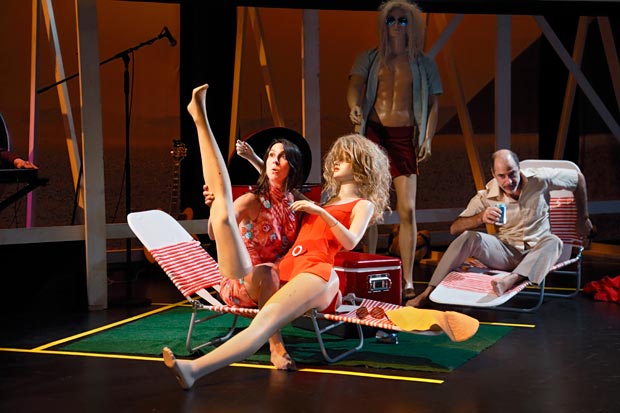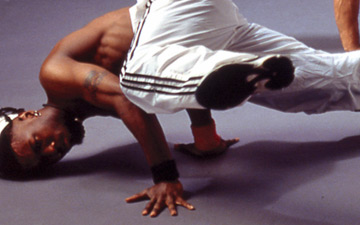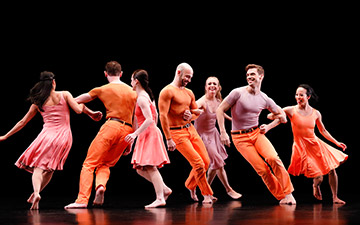
© Nichole Canuso Dance Company. (Click image for larger version)
Nichole Canuso Dance Company
Pandaemonium
★★★✰✰
New York, NY Live Arts
27 September 2016
nicholecanusodance.org
newyorklivearts.org
Some artists focus on movement, others prioritize emotion. Nichole Canuso is adept at syncing the two, mapping them out with meticulous attention to detail in her latest, multimedia dance theatre work, Pandaemonium.
The Philadelphia-based artist collaborated with theatre artist Goeff Sobelle (founding director of Early Morning Opera), visual artist Lars Jan and musician Xander Duell (an Early Morning Opera collaborator). Utilizing live filming and video projections, Canuso’s Pandaemonium takes the audience on an atmospheric journey through coupledom, intimacy and isolation.
Opening with a tableau of two mannequins (one male, one female) upstage, two very still bodies (Canuso and Sobelle) on plastic chaise lounges in front of them and a film projection of desert scenes and architectural explosions, we know we are in a place of surreality. Much of the screened imagery in the prologue appears taken from West Coast photographer Richard Misrach’s Desert Cantos – an ongoing series in which Misrach captures the mundanity of man and the elements, the inherently disruptive, but also minute influence of the human presence in the American desert’s vast landscape. Antonioni’s Death Valley scenes from “Zabriskie Point” also makes it into the visuals.
After a while, the lounging bodies begin to move. Canuso wanders stage right, later, Sobelle stage left, each of them accompanied by a sturdy mid-century table. Their individual movements are captured on film, forming a composite video on the big screen – this element, made possible by Jan, is central to the entire work. Canuso reaches her arm out into empty space, but on film she is stroking Sobelle’s face. It begs the question as to whether or not their bodies were filmed live, or if Canuso matched the choreography perfectly with a pre-made film. After minutes of meditating on this possibility, it became clear it was being done live: it was too real, down to breathing patterns, twitches and blinking eyes.
A glimmer of a narrative appears when Canuso takes a folder and some paper and places them out on her table. Sobelle, who has miraculously found a bottle of liquor in a potted plant, “signs” imaginary paperwork on his blank table, their two actions made reality in the composite film. A divorce or legal parting is the only thing it could be. Both, individually, still using their separate tables as props, start acting drunk silly, swirling and flailing about, creating a mesmerizing film when the images of their bodies are made fluid together onscreen. How Canuso choreographed this in collaboration with visual maestro Jan, down to what must be a millimeter for it to work on film is an unbelievable feat. The movement is athletic physical comedy of the type only dance and theatre people could do, but something Carol Burnett would appreciate.
In a brilliant turn of tragicomedy, Canuso waltzes with the female mannequin. As she swings the unwieldy body around, the mood is both absurd and highly emotional: the ridiculous, waxy blonde wig falls off, hips break from the torso, body parts dangle and crash to the stage. The audience is roaring and then, silent. Canuso personifies loneliness and an acute desire for companionship: romance is reduced to memory, intimacy a phantom limb. Sobelle mimics her with two dismembered mannequin arms, and his actions are hilarious but bear a touch less pathos.
Canuso turns the film factor up a notch when she grabs a dismembered steering wheel and faces a camera, upstage. A fan is blowing her hair wildly behind her, and Sobelle wheels around on a dolly with two lights, drinking like a lithe drunk all the while swiveling around to create a headlight effect in the projected film. It’s difficult to know what to watch, Sobelle is hilarious, quick on his feet, Canuso has her back to the audience and is gesticulating wildly, singing along to Xander Duell’s rock jams, and on the screen she is a woman alone, driving away from everything. The long drive dissolves soon enough into a solo headbanging session with Canuso thrashing her body around with wild abandon, a “dance like nobody’s watching” moment.
There are intermittent filmic episodes with the mannequins being burned in cauldrons, and the two of them wandering around the desert either half naked or in dashikis. But what is more interesting is when Canuso and Sobelle tumble and tussle under and over one of the tables, they surf it, jump on and slide off of it and under it in a beautifully smooth, but spiky and punctuated sequence that ends in them spooning on top of the table.
On screen the two of them are in a suburban desert house, he is drinking and she brings him papers to sign. He signs them thoughtlessly and toasts to her. Then the screen pulls away again, and the two of them are watching the two new divorcees on film on a drive-in screen (a la Misrach). A story within a story within a story – it was trippy but hopefully helped those who, like me, were teared up at the thought of this quirky couple signing on the dotted line, and calling it quits.
The project has some flaws, some sections are tedious and seem unnecessary, edits could be made for a tighter, more concise delivery of the story and or meditation on humanity Canuso is trying to get across. The film work is astonishing, the choreography in order to work within this structure, equally so, and the humor, wit and pathos of Sobelle with Canuso is deeply affecting. Musician Xander Duell begins a know it all musician in an egg cup chair who disappears with a swivel and returns to accompany the work periodically throughout, with larger and larger Rod Stewart hair each time, his vocals wrenched out of him at the very end with exhaustive, extroverted emotion, not unlike Conor Oberst of Bright Eyes. The comic angles can be as hilarious as they are touching and tragic. Certain vignettes were brilliant, while others seemed either unnecessary to the overall mood or plot, or go on too long.
Canuso created the work to explore “isolation in our digitally enhanced world,” and for all the masterful technological feats used in this production, the visual dismemberment and composite creation of the couple, Pandaemonium at its heart still tackles age-old, very primal human emotions and conundrums. The very human sense of isolation is ironically exacerbated by our seemingly “connected” tech-happy world, with smartphones capable of turning an entire bar full of people into a party of screen-staring wallflowers, but isolation itself is an age-old aspect of the human experience. Nevertheless, Canuso proves herself an artist who effectively makes her audience think, observe and recognize certain aspects of the human condition, as tender and vulnerable as they are cruel.

















You must be logged in to post a comment.